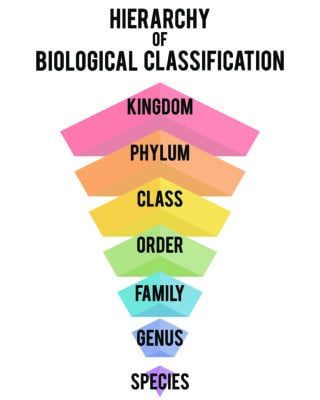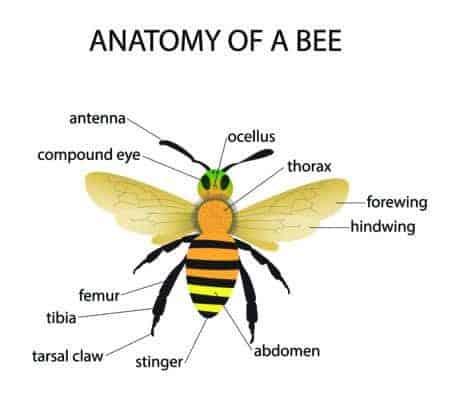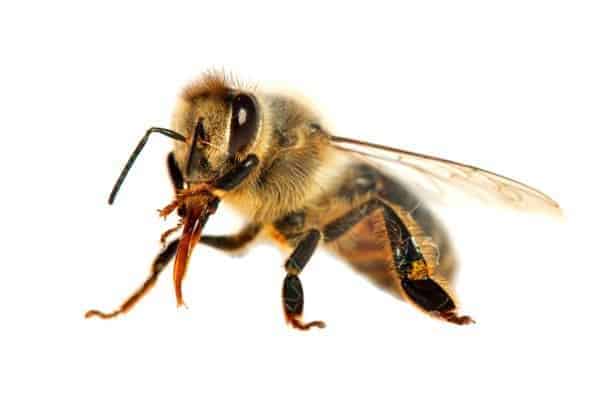Without any doubt, bees are some of the most fascinating, beloved, and productive critters in the world. With their ability to pollinate plants, the bumbling little creatures have a major role in the ecosystem.
Their distinctive stripes also make them fairly easy to identify in your garden. But whether you’re a keen beekeeper, or just beginning to explore the wonderful world of bees, it’s normal to have some questions like:
“What is a bee anyway? Is it an insect? A bug? Is there even any difference?”.
It can sure feel confusing. But, don’t worry, here at HoneyBeeHQ we’ve been busy bees researching the answers to your questions for you!
Firstly, let’s look at the easy answers to your questions:
Yes, bees are insects and technically not bugs. Bees have four features they share with bugs. These features are:
- A well-defined head, thorax, and abdomen.
- Three pairs of legs
- Two pairs of wings (Insects have one or two pairs of wings)
- Long segmented antennae
The difference is bugs have a straight mouth that can puncture and bees have a retractable mouth that can suck.
Now, let’s look at what makes a bee an insect in a little more detail:
What is an insect anyway?
While ‘insect’ is commonly used in colloquial and everyday language, it is also a scientific term with a clear definition. And this can sometimes cause confusion.
The Merriam-Webster dictionary defines the word insect as any of a class (Insecta) of arthropods (such as bugs or bees) with well-defined head, thorax, and abdomen, only three pairs of legs, and typically one or two pairs of wings or any of numerous small invertebrate animals (such as spiders or centipedes) that are more or less obviously segmented —not used technically”
As you can see, the technical definition of an insect (shown under definition 1a) refers to quite a specific set of characteristics.
Definition 1b on the other hand is a lot less specific!
That’s because lots of people confuse everything that is crawling and spooks them out with insects.
However, most people are not scientists, and when we are speaking colloquially, we don’t always need to be overly precise over the definition.
And that means that it’s important that we do look at the scientific definition of insects. That way, you can see how our friends the bees fit in.
Ok, we’ve already seen that a member of the insect ‘class’ has a well-defined head, thorax, and abdomen, only three pairs of legs, and typically one or two pairs of wings. But some of the terms we’ve seen so far are pretty technical. So, let’s break it down a little further:
What do we mean when we say ‘class’ and what are ‘arthropods’?
In the dictionary definition of ‘insect’, we see these two terms being introduced. But what do they mean?
Well, since the world of living organisms is so large, scientists need ways to group related creatures together in order to learn about them.
To do this, they use a scientific classification system of living things called the ‘Taxonomic Hierarchy’ which goes like this:

- Domain- This is the broadest category and includes just three groups: Bacteria, Archaea, and Eukaryota. Bees, along with humans, fall under the Domain Eukaryota.
- Kingdom- This category places living things into slightly narrower groups including plants and animals. Bees fall into the ‘Animalia’ or animal class.
- Phylum-The next category ‘Phylum’ breaks things down even further. There are 35 Phyla in the Kingdom Animalia, including arthropods! Arthropods are a category of Phylum whose members have jointed legs and exoskeletons… just like bees!
- Class- ‘Class’ helps us narrow living things down even further. In the animal kingdom of which our beloved bees belong, there are 108 classes. Bees belong to the ‘Insecta’ Class. As we have already seen, insects have a well-defined head, thorax, and abdomen, only three pairs of legs, and typically one or two pairs of wings. But there are 9,000 known types of insects in the world. And that means we need to narrow things down a little more.
- Order- Luckily, the ‘Order’ in which a living thing belongs is even more specific than the Class. Bees belong to the Order ‘Hymenoptera’. This translates to ‘membraned wings’ and incorporates critters like wasps and sawflies along with all types of bees.
- Family- The ‘Family’ in which something belongs is, you guessed it: even more specific! In fact, bees get a family all to themselves: Apidae which means bee in Latin.
- Genus- The ‘Genus’ down families into smaller groups. In the case of bees, there are two possible categories: Apis and Bombus. Honeybees are part of the Genus ‘Apis’.
- Species- ‘Species’ refers to the name of a very narrow category of a living creature. For example, a cat, chicken, or chimpanzee. The scientific name for the species we call a honeybee is: ‘Mellifera’.
So, what does all of this tell us? Well, as we can see from the Taxonomic Hierarchy, both ‘Arthropod’ and ‘Class’ refer to ways in which we can classify what makes a bee, and how they relate to their closest relatives.
To understand how a bee fits into the insect Class, it helps to look at their anatomy in a little more detail:
A bees anatomy:
When you think of a bee, you probably picture those famous stripes (and perhaps that stinger hiding a painful surprise!). But the bee body is way more complex than our general idea about them. The anatomy of the bee can verify exactly why they are classed as insects:
- A well-defined head, thorax, and abdomen- Looking at the above image, it is clear that the body of the bee consists of three distinct sections: a head that houses the eyes; a thorax or midsection that holds the legs and wings, and an abdomen.
- Only three pairs of legs- As we can see from the image above, a bee has just three pairs of legs.
- Typically one or two pairs of wings – Again, by looking at the image above, we can see that our friend the bee has wings (well, how else are they supposed to fly from flower to flower collecting sweet nectar?).

Ok, so we’ve seen what makes a bee an insect. But where does that leave bugs? Let’s take a look:
What is a bug?
Many of us use the terms ‘bug’ and ‘insect’ interchangeably. And this is fine when we are speaking colloquially.
But when it comes down to a science, there is a difference in meaning between the two terms.
So, what exactly is this difference?
Well, remember further up the page where we discussed ‘Orders’ as part of the Taxonomic Hierarchy? Bugs are part of an Order of insects called ‘Hemiptera’.
As well as having three well-defined body sections, only three pairs of legs, and (usually) one or two pairs of wings, Hemiptera has:
- Long, segmented antennae
- A straight, straw shaped mouth used to puncture plants or animals
- And wings that are dark where they meet the body before turning lighter at their ends
This means that all bugs are a type of insect. But all insects are not technically bugs.
And while bees do meet some of the criteria of a bug, their mouths set them apart. You see, a bee has a retractable mouth rather than a straight mouth which is used to suck without puncturing its food source.

Of course, even the most pedantic insect expert knows that most people lump bugs and insects together. Luckily, scientists have come up with a solution to avoid confusion: when talking about bugs in a technical, scientific way, they refer to bugs as ‘true bugs’.
This is especially useful when you consider that many insects with ‘bugs’ in their name, like ladybugs, aren’t actually bugs at all!
So there we have it, bees are most definitely insects. And technically speaking, they are not bugs… Though we won’t judge you if you continue to call them that!
